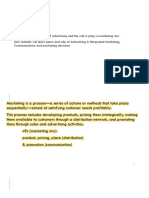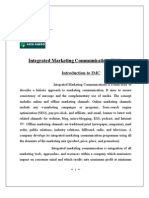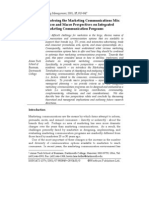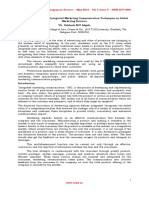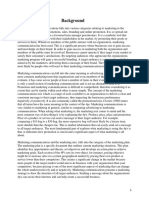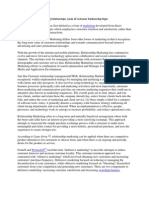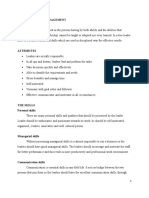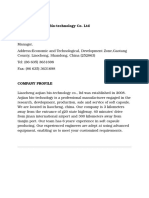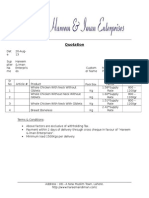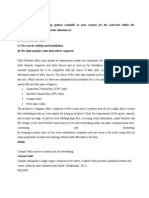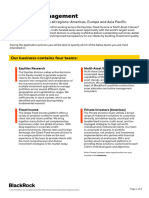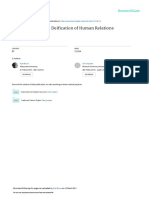Wella Is Germany
Wella Is Germany
Uploaded by
Akhtar AliCopyright:
Available Formats
Wella Is Germany
Wella Is Germany
Uploaded by
Akhtar AliOriginal Description:
Original Title
Copyright
Available Formats
Share this document
Did you find this document useful?
Is this content inappropriate?
Copyright:
Available Formats
Wella Is Germany
Wella Is Germany
Uploaded by
Akhtar AliCopyright:
Available Formats
Wella is Germany's largest--and the world's second-largest--producer of hairdressing products for home and professional use.
Wella AG operates in Darmstadt as the head company of the worldwide Wella Group. In the latter half of the 1980s, Wella took a significant step forward into the international hygiene-products market. This period was marked by a number of acquisitions and diversifications into new fields, by expansion into new markets, and by heavy investment in new production technology. Subsidiary companies of international importance include the French companies Parfums Rochas and Ren Garraud.
1. Critically assess the impact of the main elements of the marketing communications process on market behavior and dynamics Marketing communications is a management process through which an organization engages with its various audiences. Through understanding an audiences communications environment, organizations seek to develop and present messages for their identified stakeholder groups, before evaluating and acting upon the responses. By conveying messages that are of significant value, they encourage audiences encouraged to offer attitudinal and behavioral responses. Marketing communication functions within a marketing framework. The primary goal of marketing communication is to reach a defined audience to affect its behavior by informing, persuading, and reminding. Marketing communication acquires new customers for brands by building awareness and encouraging trial. Marketing communication also maintains a brand's current customer base by reinforcing their purchase behavior by providing additional information about the brand's benefits. A secondary goal of marketing communication is building and reinforcing relationships with customers, prospects, retailers, and other important stakeholders. Successful marketing communication relies on a combination of options called the promotional mix. These options include advertising, sales promotion, public relations, direct marketing, and personal selling. The Internet has also become a powerful tool for reaching certain important audiences. The role each element takes in a marketing communication program relies in part on whether a company employs a push strategy or a pull strategy. A pull strategy
relies more on consumer demand than personal selling for the product to travel from the manufacturer to the end user. The demand generated by advertising, public relations, and sales promotion "pulls" the good or service through the channels of distribution. A push strategy, on the other hand, emphasizes personal selling to push the product through these channels.
2. Explain the marketing communications structure, processes and links between each stage of the process
Marketing communications normally covers personal selling , media advertising , direct response marketing , sales promotion and public relations. The range of activities / tools available to an organizations to communicate with its target
3. Explain
the
role
of
the
marketing
communications
plan
within
an
organizations strategy and culture
Marketing communications recognize the increasing role that the organization plays in the marketing process, and the impact that organizational factors can have on the minds of audiences. As the structure, composition and sheer number of offerings in some markets proliferate, so differences between products diminish , to the extent that it has become much more difficult to differentiate between products. This results in a decrease in the number of available and viable positioning opportunities. One way to resolve this problem is to use the parent organisation as an umbrella, to provide greater support and leadership in the promotion of any offerings hence the earlier reference to the emerging strength of corporate marketing. A view that is becoming increasingly popular is that corporate strategy should be supported by the organizations key stakeholders if the strategy is to be successful. Strategy must be communicated in such a way that the messages are consistent through time, and are targeted accurately at appropriate stakeholder audiences. Each organization must constantly guard against the transmission of confusing messages, whether this be through the way in which the telephone is answered, the navigability of a website, the impact of sales literature, or the way salespersons approach prospective clients. Many organizations recognize the usefulness and importance of good public relations. This is because of the high credibility attached to the messages received and the relatively low operational costs. As a result, the use of corporate advertising has grown. Finally, marketing communications recognize the development of channel or trade marketing. Many organizations have moved away from the traditional control of a brand manager to a system that focuses upon the needs of distributors and intermediaries in the channel. Organizations in the channel, work together to satisfy their individual and collective objectives. The degree of conflict and cooperation in the channel network depends upon a number of factors, but some of the most important are the form and quality of the communications between member organizations. This means that marketing communications must address the specific communication needs of members of the distribution network and of those other stakeholders who impact on or who influence the performance of the network. Indeed, marketing communications recognize the need to contribute to the communications in the channel network, to support and sustain the web of relationships. For example, many organizations in the airline industry have shifted their attention to the needs of the travel trade, customers and competitors. United Airlines, British Airways, KLM,
Qantas and other airlines have changed their approach, attitude and investment priorities so that channel partnerships and alliances are of particular priority. Now there is a clear emphasis on working with their partners and their competitors (e.g. British Airways and KLM), and this entails agreement, collaboration and joint promotional activity in order that all participants achieve their objectives.
4. Critically evaluate how tools of the communications mix can be coordinated
effectively The marketing communications mix consists of a set of tools (disciplines) that can be used in various combinations and different degrees of intensity in order to communicate with a target audience. In addition to these tools or methods of communication, there are the media, or the means by which marketing communications messages are conveyed. Tools and media should not be confused, as they have different characteristics and seek to achieve different goals. There are five principal marketing communications tools : advertising, sales promotion, public relations, direct marketing and personal selling. However, there have been some major changes in the environment and in the way organizations communicate with their target audiences. New technology has given rise to a raft of different media, while people have developed a variety of ways to spend their leisure time. This is referred to as media and audience fragmentation, and organizations have developed fresh combinations of the promotional mix in order to reach their audiences effectively. For example, there has been a dramatic rise in the use of direct-response media as direct marketing becomes adopted as part of the marketing plan for many products. The Internet and digital technologies have made possible new interactive forms of communication, where the receivers have greater responsibility for their part in the communication process. An increasing using communicate themselves relations) and also brands. number public both of organizations are to about public relations messages (corporate
messages about their
5. Examine the importance to marketing communications activities of developing long-term relationships with customers, agencies, and stakeholders
The relationship marketing process is usually described as one of establishing, developing and maintaining successful relational exchanges (Morgan and Hunt, 1994). The essence of these activities is to decrease exchange uncertainty and to create customer collaboration and commitment through gradual development and ongoing adjustment of mutual norms and shared routines. If customers are retained over several transactions, both buyers and sellers may profit from the experience gained through previous transactions. The basic aim is to increase profits by attaining a rising proportion of specific customers' lifetime spending rather than to maximize profits from individual transactions (Palmer, 1994). Thus, the development of customer-supplier relationships may be described as a set of cumulative phases during which the trustworthiness of suppliers and buyers is tested and mutual norms governing exchange activities are developed. Several relationship marketing scholars agree that communication is a fundamental aspect of relationship development. Communication is the quintessence of coordinating behaviour in any organizational setting, and marketing relationships are no exception (Cummings, 1984; Hutt and Speh, 1995). Communication is said to be the glue that holds together an inter-organizational channel of distribution (Mohr and Nevin, 1990). In the present paper, communication is defined as the human act of transferring a message to others and making it understood in a meaningful way. This definition focuses on the efficacy of communication in producing the desired effect rather than on the frequency or modality of information exchange. In marketing relationships, communication plays a central role in providing an understanding of the exchange partners' intentions and capabilities, thus forming the groundwork for relationship development. Communication is a prerequisite for building trust among exchange partners (Anderson and Narus, 1990). The quality and sharing of information influence the success of relationships (Mohr and Spekman, 1994) and are a central part of the relationship atmosphere (Hallen and Sandstrom, 1991). Moreover, communication informs the exchange actors when they develop their conception of the prospective partner's exchange intentions (Andersen and Srensen, 1999). Hence,
careful design of communication means and forms may play a decisive role in the relationship marketing process.
You might also like
- Marketing CommunicationDocument8 pagesMarketing CommunicationAruna EkanayakaNo ratings yet
- Grade7-A Shawl For AnitaDocument5 pagesGrade7-A Shawl For AnitaJovelle Reyes50% (2)
- The Role of Communication in Contemporary MarketingDocument4 pagesThe Role of Communication in Contemporary MarketingdanookyereNo ratings yet
- Unit1 PDFDocument91 pagesUnit1 PDFasadNo ratings yet
- IMC Chap-I NotesDocument10 pagesIMC Chap-I Notesmoses tilahunNo ratings yet
- Mm3.Define MarketingDocument30 pagesMm3.Define Marketingsaeidmba1983No ratings yet
- Introduction To IMCDocument14 pagesIntroduction To IMCsimonebandrawala90% (1)
- Principles of AdvertisingDocument7 pagesPrinciples of AdvertisingOmolola MohammedNo ratings yet
- Unit 1Document41 pagesUnit 1KAUSHAN DEYNo ratings yet
- Integrated Marketing CommunicationDocument95 pagesIntegrated Marketing CommunicationSagar BorseNo ratings yet
- Sample 1Document9 pagesSample 1Deepti GuptaNo ratings yet
- Chapter 1 MineDocument12 pagesChapter 1 MineBereket MinaleNo ratings yet
- Marketing - Chapter 15Document4 pagesMarketing - Chapter 15Fabian NonesNo ratings yet
- Keller, Analysing Factors Influencing Marketing Communication Effectiveness Along FourDocument29 pagesKeller, Analysing Factors Influencing Marketing Communication Effectiveness Along FourPernille Vittrup100% (1)
- Prospects & Future of Integrated Marketing Communication Techniques in Global Marketing ServicesDocument6 pagesProspects & Future of Integrated Marketing Communication Techniques in Global Marketing ServicesarcherselevatorsNo ratings yet
- Belch 12e IM Ch01Document18 pagesBelch 12e IM Ch01YogeshNo ratings yet
- Background: AdvertisingDocument22 pagesBackground: AdvertisingyolandaNo ratings yet
- IMC Belch and Belch Chapter 1Document20 pagesIMC Belch and Belch Chapter 1Sarah TaufiqueNo ratings yet
- Integrated Marketing CommunicationsDocument7 pagesIntegrated Marketing CommunicationsBaljinder Kumar SainiNo ratings yet
- Marketing Management: By: Megha Gaur Assistant Professor MBA DepartmentDocument26 pagesMarketing Management: By: Megha Gaur Assistant Professor MBA DepartmentKapila AroraNo ratings yet
- Understanding Integrated Marketing Communication: Concepts, Definitions and DimensionsDocument17 pagesUnderstanding Integrated Marketing Communication: Concepts, Definitions and DimensionsSanjana SinghNo ratings yet
- Managing Mass CommunicationsDocument2 pagesManaging Mass Communicationsaseem888No ratings yet
- Conventional Marketing ChannelDocument13 pagesConventional Marketing Channelঘুমন্ত বালকNo ratings yet
- IMC CadburyDocument39 pagesIMC CadburyPayal Ambhore0% (1)
- IMC Notes 1Document5 pagesIMC Notes 1Ashwani Singh100% (1)
- Marketing Mix - PromotionDocument7 pagesMarketing Mix - PromotionRagulan50% (2)
- Name: Sachin Kumar Student I'D: Q1004197 Module Name: Foundation of Marketing and CommunicationDocument13 pagesName: Sachin Kumar Student I'D: Q1004197 Module Name: Foundation of Marketing and CommunicationShashank JainNo ratings yet
- Promotion Notes PDFDocument45 pagesPromotion Notes PDFkp100No ratings yet
- Marketing Mix of Financial ServicesDocument8 pagesMarketing Mix of Financial ServicesVibha Pewal0% (1)
- A Brief Introductionto Integrated Marketing CommunicationDocument39 pagesA Brief Introductionto Integrated Marketing CommunicationAbhimanyu VermaNo ratings yet
- Paper of Marketing Tourism Chapter16Document8 pagesPaper of Marketing Tourism Chapter16Pipo AngsyarullahNo ratings yet
- Communicating ValuesDocument58 pagesCommunicating Valuesnoushad kNo ratings yet
- Role and Objective of Marketing CommunicationDocument48 pagesRole and Objective of Marketing CommunicationHari Naghu91% (11)
- Relationship Marketing and Organizational Performance IndicatorsDocument13 pagesRelationship Marketing and Organizational Performance IndicatorsAnonymous DjaxnMaNo ratings yet
- Integrated Marketing Communications Is The Coordination and Integration of All MarketingDocument4 pagesIntegrated Marketing Communications Is The Coordination and Integration of All MarketingMehfuz PatelNo ratings yet
- Relationship Marketing - PPTX IntroDocument80 pagesRelationship Marketing - PPTX IntroGift MabikaNo ratings yet
- IMC Notes - 1Document5 pagesIMC Notes - 1Heet DoshiNo ratings yet
- Advertising Class NotesDocument38 pagesAdvertising Class Notesyusuf1183100% (4)
- Integrated Marketing Communication - Postgraduates - PowerpointDocument93 pagesIntegrated Marketing Communication - Postgraduates - PowerpointCornelius DarkwaNo ratings yet
- Introduction To Imc 1Document14 pagesIntroduction To Imc 1zaaabirhooosaunNo ratings yet
- Pdf24 MergedDocument53 pagesPdf24 Mergedchauhanshivani3053No ratings yet
- Integrated Marketing CommunicationDocument37 pagesIntegrated Marketing Communicationadi.handeNo ratings yet
- Question 1 & 2 SegaDocument4 pagesQuestion 1 & 2 SegaJotham ShumbaNo ratings yet
- Evolution of IMCDocument6 pagesEvolution of IMCtalen14100% (2)
- 3.4 Promotion - Communication Mix - Ankit SharmaDocument28 pages3.4 Promotion - Communication Mix - Ankit SharmaAnkit SharmaNo ratings yet
- Chap001 RevDocument20 pagesChap001 RevKunal MojidraNo ratings yet
- IMC - The Importance of Message ConsistencyDocument2 pagesIMC - The Importance of Message ConsistencyHari Zainuddin RasyidNo ratings yet
- Advertising&MarketingDocument22 pagesAdvertising&MarketingRishab KapurNo ratings yet
- Communication, Positioning, Consumer Behaviour, Price, Market Research, ProductDocument16 pagesCommunication, Positioning, Consumer Behaviour, Price, Market Research, ProductDuy TrácNo ratings yet
- Integrated Marketing CommunicationsDocument4 pagesIntegrated Marketing CommunicationsMulong CabrillasNo ratings yet
- Advertisement As A Mean of Creating Awareness For A Product in An OrganizationDocument32 pagesAdvertisement As A Mean of Creating Awareness For A Product in An OrganizationAjewole Eben TopeNo ratings yet
- IMC NotesDocument11 pagesIMC NotesAvinash GurjarNo ratings yet
- AdvertisementDocument76 pagesAdvertisementChinthuUnnikrishnanNo ratings yet
- The Effectiveness of Marketing CommunicaDocument50 pagesThe Effectiveness of Marketing CommunicaAdina LinguraruNo ratings yet
- Customer Relationship ManmagementDocument51 pagesCustomer Relationship ManmagementmuneerppNo ratings yet
- MODULE 1-AdvertisingDocument22 pagesMODULE 1-Advertisingleslie_jetNo ratings yet
- Lesson 11 Marketing ManagementDocument6 pagesLesson 11 Marketing ManagementNmNo ratings yet
- Marketing: Relationship Marketing Was First Defined As A Form ofDocument6 pagesMarketing: Relationship Marketing Was First Defined As A Form ofVishakajNo ratings yet
- How to Sell (eCommerce) - Marketing and Internet Marketing StrategiesFrom EverandHow to Sell (eCommerce) - Marketing and Internet Marketing StrategiesNo ratings yet
- RQF 4Document12 pagesRQF 4Akhtar AliNo ratings yet
- Pharmacists: A Guide For Newcomers To British ColumbiaDocument13 pagesPharmacists: A Guide For Newcomers To British ColumbiaAkhtar AliNo ratings yet
- Healthcare in Crisis CertificateDocument1 pageHealthcare in Crisis CertificateAkhtar AliNo ratings yet
- Skilled Worker Application Guide: Nova Scotia Nominee ProgramDocument22 pagesSkilled Worker Application Guide: Nova Scotia Nominee ProgramAkhtar AliNo ratings yet
- Understanding Leading ChangeDocument4 pagesUnderstanding Leading ChangeAkhtar Ali0% (1)
- Liaocheng Aojian BioDocument1 pageLiaocheng Aojian BioAkhtar AliNo ratings yet
- Monthly Coverage Report Sept 2014Document1 pageMonthly Coverage Report Sept 2014Akhtar AliNo ratings yet
- Activity Report Sept 2014Document1 pageActivity Report Sept 2014Akhtar AliNo ratings yet
- Revised: Director (Sales & Marketing) Asst. RSMDocument1 pageRevised: Director (Sales & Marketing) Asst. RSMAkhtar AliNo ratings yet
- TS Monthly Plan DEC-2014Document1 pageTS Monthly Plan DEC-2014Akhtar AliNo ratings yet
- Quotation MetroDocument1 pageQuotation MetroAkhtar AliNo ratings yet
- Ethicsinrecruitmentandselectionautosaved 111113045344 Phpapp01Document15 pagesEthicsinrecruitmentandselectionautosaved 111113045344 Phpapp01Akhtar AliNo ratings yet
- The Hierarchy of Strategic Intent Marketing EssayDocument25 pagesThe Hierarchy of Strategic Intent Marketing EssayAkhtar AliNo ratings yet
- Research Project Outline: To Accompany Cateora/Graham/Bruning's International Marketing Canadian EditionDocument6 pagesResearch Project Outline: To Accompany Cateora/Graham/Bruning's International Marketing Canadian EditionAkhtar AliNo ratings yet
- Hand N Feet CreamDocument1 pageHand N Feet CreamAkhtar AliNo ratings yet
- What Type of Organizational Structure Does Coca-Cola Have?Document3 pagesWhat Type of Organizational Structure Does Coca-Cola Have?Akhtar AliNo ratings yet
- Estions HTMLDocument1 pageEstions HTMLAkhtar AliNo ratings yet
- Computer Network2 FinalDocument12 pagesComputer Network2 FinalAkhtar AliNo ratings yet
- Bruce Edited Not FinishDocument7 pagesBruce Edited Not FinishVictoria AlombroNo ratings yet
- BlackRock 2023-2024 Portfolio Management Job DescriptionDocument8 pagesBlackRock 2023-2024 Portfolio Management Job Descriptionharikevadiya4No ratings yet
- FDP ConsolidatedDocument14 pagesFDP ConsolidatedArup BaksiNo ratings yet
- Activity 4-RAFTDocument2 pagesActivity 4-RAFTmaria olivia mercadoNo ratings yet
- Block Medical Officer of Health, Hasnabad Pay Slip Government of West BengalDocument1 pageBlock Medical Officer of Health, Hasnabad Pay Slip Government of West BengalArkit BasuNo ratings yet
- 09 Modern Steel Construction. 11-2016Document70 pages09 Modern Steel Construction. 11-2016Claudio VillalonNo ratings yet
- Milano Centrale Railway Station: Purza Gheorghe CCIA Anul IIDocument23 pagesMilano Centrale Railway Station: Purza Gheorghe CCIA Anul IIRazrin Lucaci50% (2)
- Calico RulesDocument16 pagesCalico RulesTomás SánchezNo ratings yet
- Gs33j01a00-00en 003Document4 pagesGs33j01a00-00en 003bmw316No ratings yet
- TDS - Fischer XRF SystemDocument48 pagesTDS - Fischer XRF SystemSRANNo ratings yet
- Information 15 00039Document20 pagesInformation 15 00039Jc OlimpiadaNo ratings yet
- Dont Drink and DriveDocument2 pagesDont Drink and Driveapi-675558217No ratings yet
- Elton Mayo Theory DeficationDocument25 pagesElton Mayo Theory DeficationMondayNo ratings yet
- Exam Result Sheet Dsce MakeupDocument1 pageExam Result Sheet Dsce MakeupSohan d pNo ratings yet
- Banquet and Catering ExamDocument6 pagesBanquet and Catering ExamRoy AmoresNo ratings yet
- Copper Acute Toxicity Tests With The Sand Crab Emerita Analoga (Decapoda: Hippidae) : A Biomonitor of Heavy Metal Pollution in ...Document9 pagesCopper Acute Toxicity Tests With The Sand Crab Emerita Analoga (Decapoda: Hippidae) : A Biomonitor of Heavy Metal Pollution in ...rossan LOPEZ TARAZONANo ratings yet
- Strategies 19-26Document8 pagesStrategies 19-26Tor ToteNo ratings yet
- AEE462 - Project - Part 1 - Spring 2022Document4 pagesAEE462 - Project - Part 1 - Spring 2022öznur uluNo ratings yet
- Aia 600 2 T110Document3 pagesAia 600 2 T110Sharom Zelene Cordova RomanNo ratings yet
- Physics Study GuideDocument12 pagesPhysics Study Guidebmack21No ratings yet
- Chapter2 - ER ModelDocument80 pagesChapter2 - ER ModelRashika KhannaNo ratings yet
- CPVC - Price List - 7th Oct 2022Document16 pagesCPVC - Price List - 7th Oct 2022Vijay SharmaNo ratings yet
- Chapter 3: Functions and Their Graphs Learning OutcomeDocument26 pagesChapter 3: Functions and Their Graphs Learning OutcomeLabibz HasanNo ratings yet
- Data Analytics Assignment 1Document11 pagesData Analytics Assignment 1RADHIKA CHANDAKNo ratings yet
- Beauty and The Beast A Fairy Tale of TourismphobiaDocument19 pagesBeauty and The Beast A Fairy Tale of TourismphobiaAlexandre Mansão dos SantosNo ratings yet
- Chapter 3 - Research MethodologyDocument7 pagesChapter 3 - Research MethodologyDevi PadmavathiNo ratings yet
- Important Tips On The Calibration and Adjustment of The Testo 270Document1 pageImportant Tips On The Calibration and Adjustment of The Testo 270Abu AlifNo ratings yet
- Teori Analisis Step Drawdown TestDocument8 pagesTeori Analisis Step Drawdown TestarkoesteaNo ratings yet








